ACHECK LIST OFLEAFHOPPER FAUNA(HEMIPTERA: CICADELLIDAE) IN ANDHRA PRADESH.
0 Views
M.S.V. CHALAM1* AND P. SEETHA RAMU2
Department of Entomology, S V Agricultural College, ANGRAU, Tirupati, Chittoor Dt., 2Agricultural College,Naira, ANGRAU, Srikakakulum Dt., Andhra Pradesh
ABSTRACT
A check list of leafhopper fauna associated with different crop-ecosystems in Andhra Pradesh was prepared. A total of 116 species belonging to 44 genera and 21 tribes were identified from Andhra Pradesh. The tribes viz., Deltocephalini, Empoascini and Erythroneurini were found to be the dominant tribes including 47 species among the described list. The genus Maiestas was found to be the most predominant genus including 22 species. Among the leafhopper fauna, Austrogallia bifurcata Sawaisingh and Gill, Exitianus indicus (Distant), E. nanus (Distant), N. virescens (Distant), M. vulgaris Dash and Viraktamath, M. dorsalis Motschulsky, M. subviridis (Metcalf), Amrasca devastans (Distant), Emopasca (Empoasca) kerri Pruthi , E. (E.) motti Pruthi, E. (E.) spirosa Dworakowska and Viraktamath, E. maculifrons (Motschulsky), Seriana jaina (Distant), Hecalus ghaurii Ramasubba Rao and Ramakrishnan, H. porrectus (Walker), H. prasinus (Matsumura), Balclutha incisa (Matsumura), B. saltuella (Kirschbaum), Cicadulina (Cicadulina) bipunctata (Melichar), Hishimonus phycitis (Distant), Doratulina rubrolineata (Distant) and D. rotundus (Pruthi) were predominant and found to be associated with a number of crop-ecosystemsA list of these leafhoppers and associated crop- ecosystems / source was provided.
KEY WORDS:
Hemiptera, Cicadellidae, Leafhoppers.
INTRODUCTION
Leafhoppers, an economically important group of Auchenorrhynchan Hemiptera belong to the family Cicadellidae comprising about 2,445 described genera and 22,637 species World wide and 340 genera and 1,350 spe-cies in India, respectively (Viraktamath, 2005). Leafhop-pers are small wedge shaped insects of various forms, colours, sizes and can be readily distinguished from other Auchennorrhyncha by having one or more rows of small spines extending the length of hind tibiae. They are phy-tophagous and commonly suck sap from leaves, although many species are known to feed on different parts of the plant. Many of the members of Cicadellidae are very serious crop pests that suck sap directly from vital cells and tissues of plants resulting in damage to leaves and stems thus producing general symptoms like curling of leaves, bronzing, drying and followed by withering and death of plants. The oviposition of leafhoppers causes injury to leaf veins and sheets. A few groups of leafhop-per genera act as vectors and transmit phytopathogenic
organisms (viruses, mycoplasmas, spiroplasmas and bac-teria) that cause diseases and eventual death of plants. Some of the diseases caused by phytopathogenic organ-isms vectored by leafhoppers include, little leaf of brinjal, sesamum phyllody, purple top role of potato, yellow dwarf of rice, rice tungro (Muniyappa and Veeresh, 1986), rice transitory yellowing, sandal spike, eastern wheat striate virus and maize streak virus, orange leaf of rice, etc., (Wilson and Claridge, 1991).
Since independence efforts were made to improve the yield of crops by introduction of high yielding varieties (HYV) and hybrids and adoption of improved agronomic practices. Many of the HYV’s and hybrids are generally susceptible to insect pests. Also, due to changes in agro-nomic practices some of the minor and / or unknown pests may assume the status of major pests. For example, the rice green leafhoppers and planthoppers which were mi-nor pests prior to the seventies, have now assumed major pest status (Kalode, 1983). The accurate identification of a pest species affecting the crop ecosystem is the first –
and fore most step for its effective suppression in inte-grated pest management programme. In this context knowledge on the association between leafhoppers and crop-ecosystems and the occurrence of vectors species is of utmost importance.
MATERIAL AND METHODS
A large number of leafhopper specimens were collected at light, grasses, weeds, shrubs etc., in addition to different crop-ecosystems. About 10-15 to and fro net sweepings were taken each time and leafhoppers collected were aspirated from the net into a glass tube and killed with a cotton swab wetted with a few drops of ethyl acetate. The leafhoppers attracted to light were directly aspirated into a glass tube and were killed with ethyl acetate swab. The killed specimens were transferred to homeopathic vials, labeled, brought to the laboratory and dried in a hot air oven at 45-50OC, for about 5 to 6 hours. The dried specimens were stored in small glass vials and labeled. For mounting and preparing slides of genitalia the procedure suggested by Knight (1965) was followed. In the present paper the terminology advocated by Blocker and Triplehorn (1985) was followed to describe different body parts of a leafhopper.
RESULTS AND DISCUSSION
A total 116 species of leafhoppers and their asso-ciations with different crop-ecosystems were presented in table-1. Manzoor (1987) studied 33 typhlocybinae leaf-hoppers associated with vegetable crop-ecosystems and losses caused in Pakistan. Viraktamath and Viraktamath (1995) reported 123 species leafhoppers and their host plants in Karnataka. Jacob et al. (2000 and 2002) stud-ied the leafhopper fauna associated with oil seed and pulse crops and reported 40 species on oil seed crops and 41 species on pulses. Reddy and Rao (2001) reported 17 species of leafhoppers associated with vegetable crops. Kamala et al (2002) reported 23 species of leafhoppers associated with rice ecosystems in coastal Andhra Pradesh. Chalam and Rao (2005) reported 37 leafhopper species belonging to 17 genera from different graminaceous crop-ecosystems like rice, sorghum, maize, sugarcane, finger millet, pearl millet and proso millet. Ramasubbarao et al. (2006) published a handbook for the identification of leafhopper fauna (Cicadellidae: Hemi-
ptera) of Andhra Pradesh which covers the diagnosis and
keys for identification of 105 leafhoppers associated with different crop ecosystems of Andhra Pradesh along with their colour photographs.
The knowledge on leafhoppers associated with different crop-ecosystems will be a useful tool to design Integrated Pest Management strategies. This information also encourages the economic entomologists to gather further information on the host plants, ecology and biology of other species of leafhoppers, which is needed to better under stand this economically important group of insects.
References:
- Blocker, H. D and Triplehorn, B. W. 1985. External morphology of leafhoppers. In: the Leafhoppers and Planthoppers (eds. Nault, L. R and Rodriguez, J. G.) John Wiley and Sons, New York. p. 41-60.
- Chalam, M. S. V and Rao, V. R. S. 2005. Leafhopper fauna Associated with Graminaceous crops of Andhra Pradesh. In: Abstract Book of National symposium on Bio-diversity and Pest management, held on 3-4 February, at Entomological Research Institute, Loyola College, Chennai p. 76.
- Jacob, P. S., Rao V. R. S and Punnaiah, K. C. 2000. Leafhopper fauna associated with oilseed crops in Andhra Pradesh, India. Pest Management and Economic Zoology. 8(1): 11-27.
- Jacob, P. S., Rao V. R. S and Punnaiah, K. C. 2002. New records of leafhoppers (Cicadellidae : Homoptera) Associated with pulse crop-ecosystems in Andhra Pradesh. The Andhra Agricultural Journal. 49 (3&4): 256-261.
- Kalode, M. B. 1983. Leafhopper and Planthopper pests of rice in India. Proceedings of the 1st International Workshop on Biotaxonomy, Classification and Biology of Leafhoppers and Planthoppers (Auchenorrhyncha) of Economic Importance . London, 4-7 October 1982, pp. 225-245.
- Kamala, G., Rao, V. R. S and Rajasekhar, P. 2002. New records of leafhoppers associated with rice ecosystems of Andhra Pradesh, India. Pest Management and Economic Zoology. 10(1): 51-56.
- Knight, W.J. 1965. Techniques for use in the identification of leafhoppers (Homoptera: Cicadellidae). Entomologists Gazzette.16(4): 129-136.
- Manzoor, A. 1987. Host associations and losses to growth and yield to some vegetable palnts caused by Typhlocybinae leafhoppers (Cicadellideae) in Pakistan. In: Proceedings of 2nd International Workshop on Leafhoppers of Economic Importance held at Prove, Utah, USA, 28 th July
- – 1 st August, 1986, (eds. Wilson, M. R and Nault, L. R.). CIE London. p 243-250.
- Muniyappa, V and Veeresh, G. K.1986. Arthropod vectors of virus and mycoplasma diseases of plants in India. Colemania. 2 : 19-38
- Ramasubbarao, V., Chalam, M.S.V and Sudha Jacob, P. 2006. Hand book for the identification of leafhopper fauna (Cicadellidae : Hemiptera) of Andhra Pradesh, 152.
- Reddy, P. P and Rao, V. R. S. 2001. Leafhopper fauna associated with vegetable crops of Andhra Pradesh in India. Entomon. 26(2): 121-130.
- Viraktamath, C. A. 2005. Key to the subfamilies and tribes of leafhoppers (Hemiptera: Cicadellidae) of the Indian subcontinent. Bionotes. 7(1): 20-24.
- Viraktamath, S. A and Viraktamath, C. A. 1995. The leaf -hoppers (Homoptera: Cicadellidae) and their host plants in Karnataka. Karnataka Journal of Agricultural Sciences. 8 (2): 249-255.
- Wilson, M. R and Claridge, M. F. 1991. Handbook for the identification of Leafhoppers and Planthoppers of Rice. CAB International,
- Wallingford, Oxon, U.K. pp. 142.
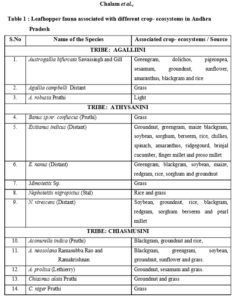
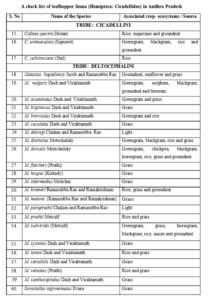
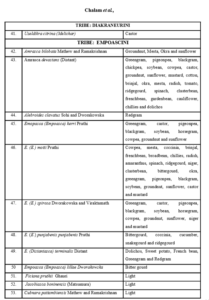
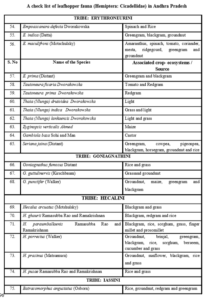
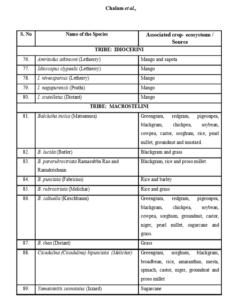
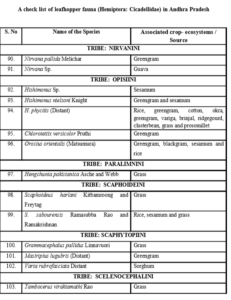
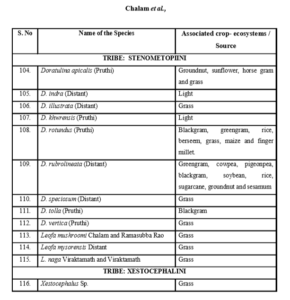
- Bio-Formulations for Plant Growth-Promoting Streptomyces SP.
- Brand Preference of Farmers for Maize Seed
- Issues That Consumer Experience Towards Online Food Delivery (Ofd) Services in Tirupati City
- Influence of High Density Planting on Yield Parameters of Super Early and Mid Early Varieties of Redgram (Cajanus Cajan (L.) Millsp.)
- Influence of Iron, Zinc and Supplemental N P K on Yield and Yield Attributes of Dry Direct Sown Rice
- Effect of Soil and Foliar Application of Nutrients on the Performance of Bold Seeded Groundnut (Arachis Hypogaea L.)

